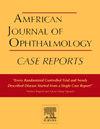Femtosecond laser-assisted half top hat penetrating keratoplasty for keratoglobus
Q3 Medicine
引用次数: 0
Abstract
Purpose
To describe a modified technique utilizing femtosecond laser-assisted penetrating keratoplasty for the surgical management of keratoglobus with an extremely thin peripheral cornea.
Methods
Two eyes of two patients with advanced keratoglobus underwent a modified, donor-only, top hat keratoplasty. Femtosecond laser-assisted top hat configuration was exclusively performed on the donor cornea (half top hat) and sutured under the recipient's cornea which underwent a regular full thickness trephination. Patients were followed up for 12–24 months after intervention. Visual acuity and anatomical results (measured using corneal tomography and anterior segment OCT) were evaluated after this intervention.
Results
Post-operatively, best corrected visual acuity improved from counting fingers in the first patient and 20/720 in the second to 20/30 in both. Keratometry values markedly decreased, and peripheral thickness was augmented in both cases. No complications during the follow-up period were noted.
Conclusions
Top hat configuration keratoplasty on donor cornea alone may be a unique surgical solution enabling the augmentation of the peripheral cornea in keratoglobus eyes, providing good visual outcomes as well as structural integrity.
飞秒激光辅助半顶帽穿透性角膜移植治疗舌状角膜
目的介绍一种飞秒激光辅助穿透性角膜移植术治疗外周角膜极薄的角膜舌状体的改进技术。方法对2例晚期角膜红蛋白患者行改良的单供体大帽角膜移植术。飞秒激光辅助的大礼帽配置是专门在供体角膜(半大礼帽)上进行的,并缝合在接受者角膜下,接受常规的全层穿孔术。干预后随访12-24个月。干预后评估视力和解剖结果(使用角膜断层扫描和前段OCT测量)。结果术后最佳矫正视力由1例和2例的手指数20/720提高到2例的20/30。角膜测量值明显下降,外周厚度增加。随访期间无并发症发生。结论单靠供体角膜进行stophat结构角膜移植术是一种独特的手术方案,可以增加角膜舌状胬肉的周围角膜,具有良好的视觉效果和结构完整性。
本文章由计算机程序翻译,如有差异,请以英文原文为准。
求助全文
约1分钟内获得全文
求助全文
来源期刊

American Journal of Ophthalmology Case Reports
Medicine-Ophthalmology
CiteScore
2.40
自引率
0.00%
发文量
513
审稿时长
16 weeks
期刊介绍:
The American Journal of Ophthalmology Case Reports is a peer-reviewed, scientific publication that welcomes the submission of original, previously unpublished case report manuscripts directed to ophthalmologists and visual science specialists. The cases shall be challenging and stimulating but shall also be presented in an educational format to engage the readers as if they are working alongside with the caring clinician scientists to manage the patients. Submissions shall be clear, concise, and well-documented reports. Brief reports and case series submissions on specific themes are also very welcome.
 求助内容:
求助内容: 应助结果提醒方式:
应助结果提醒方式:


